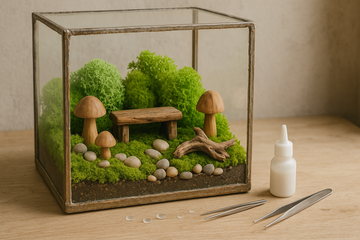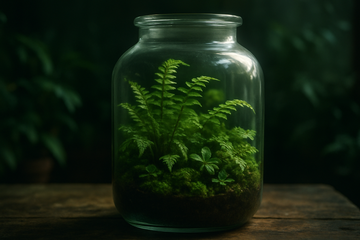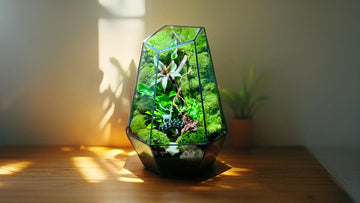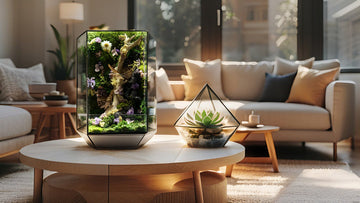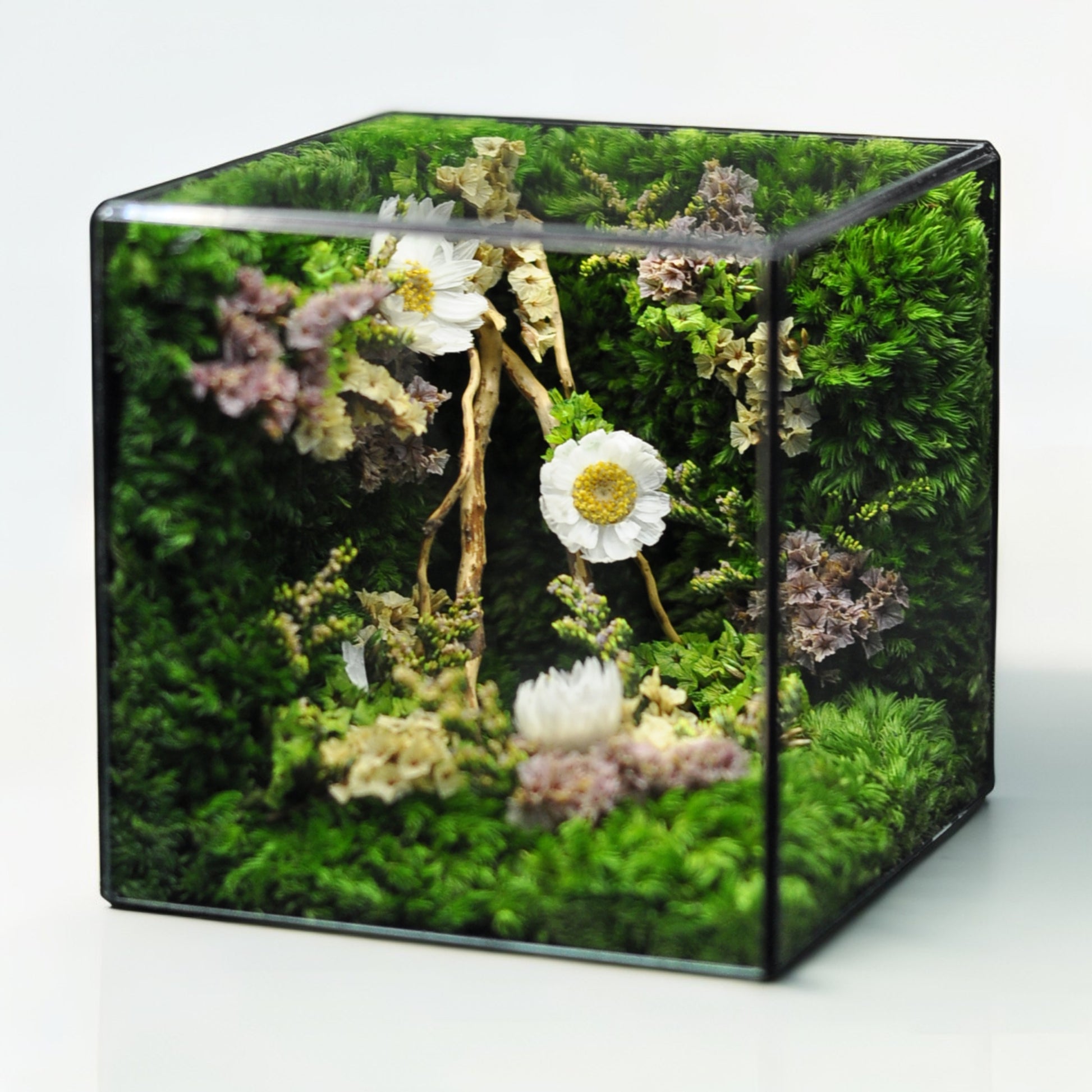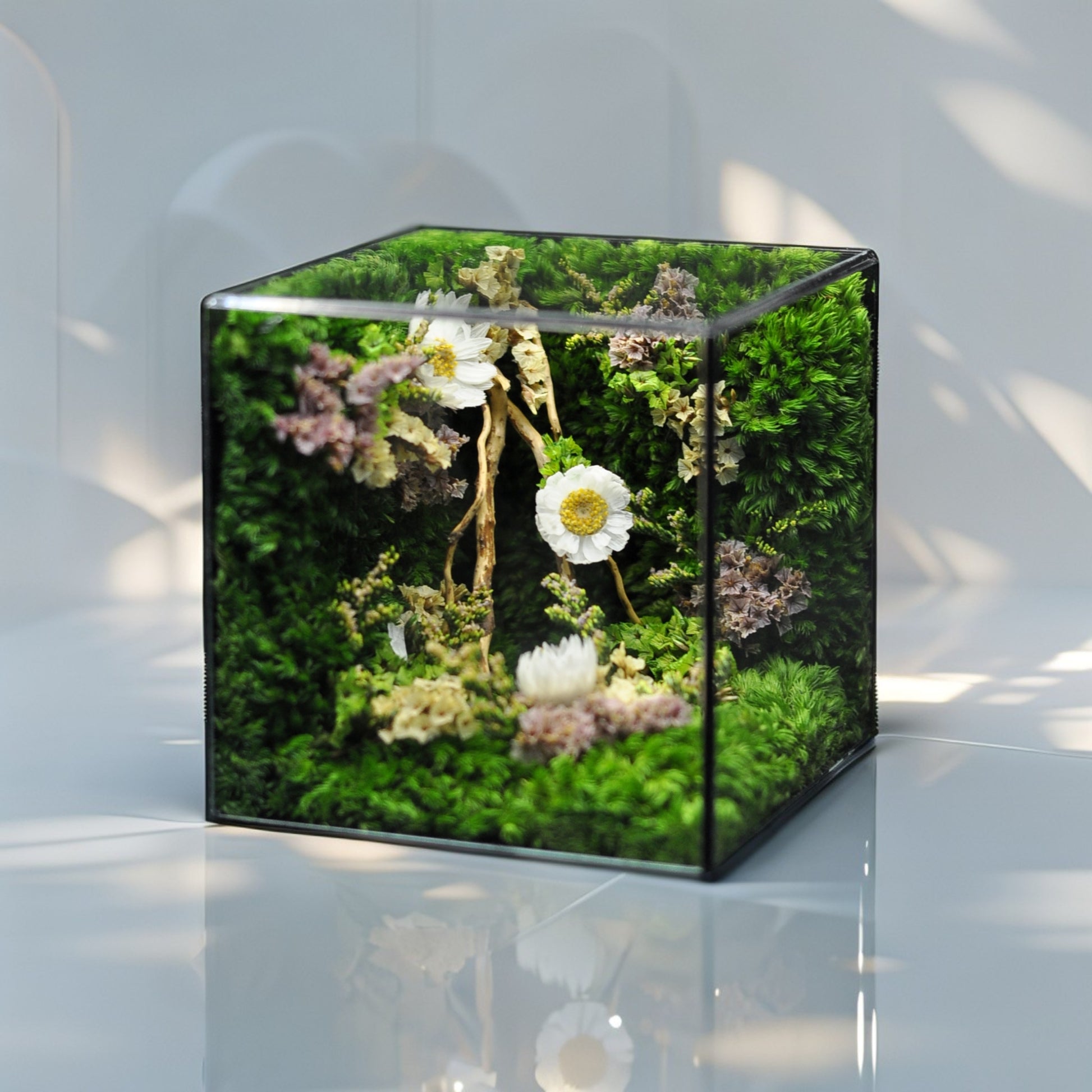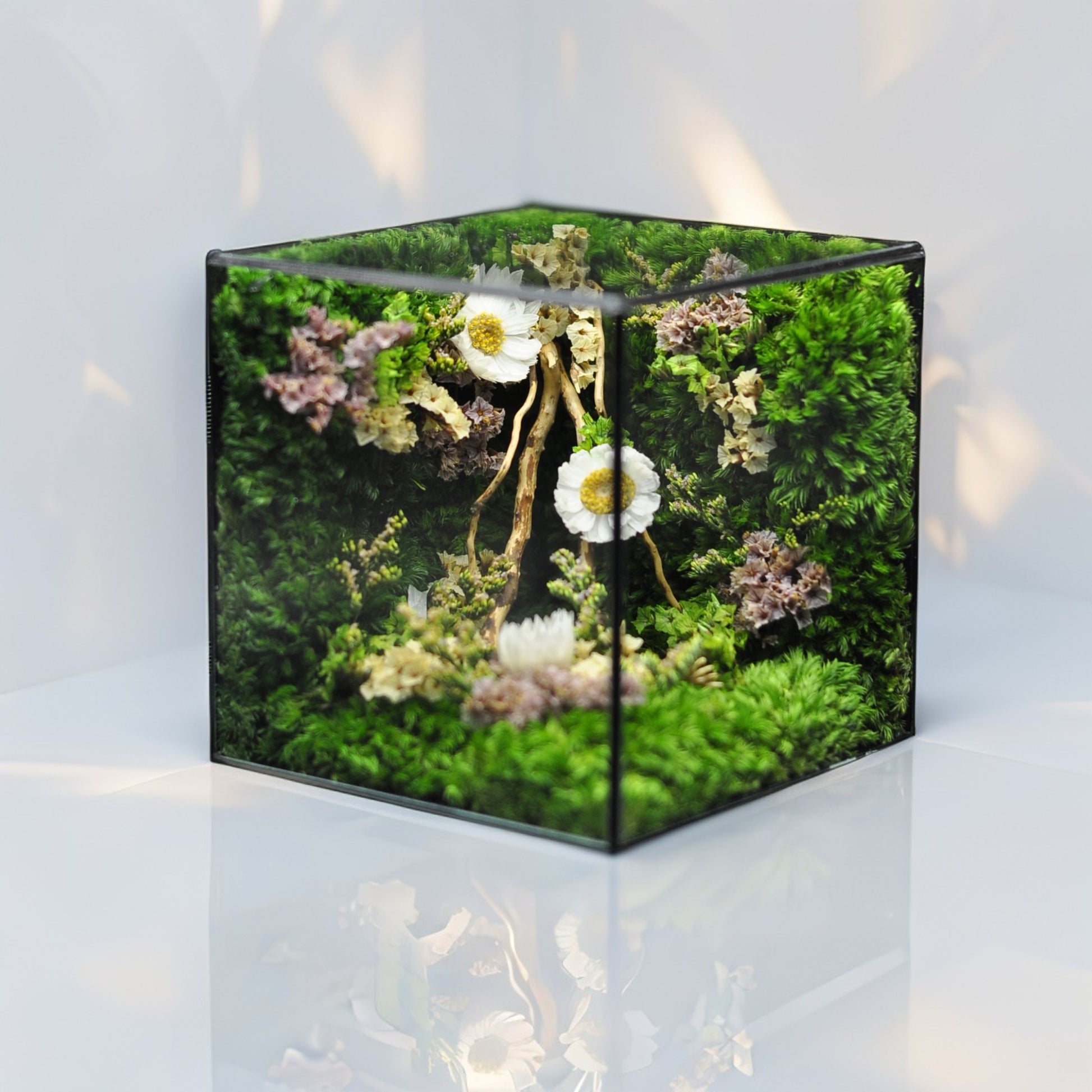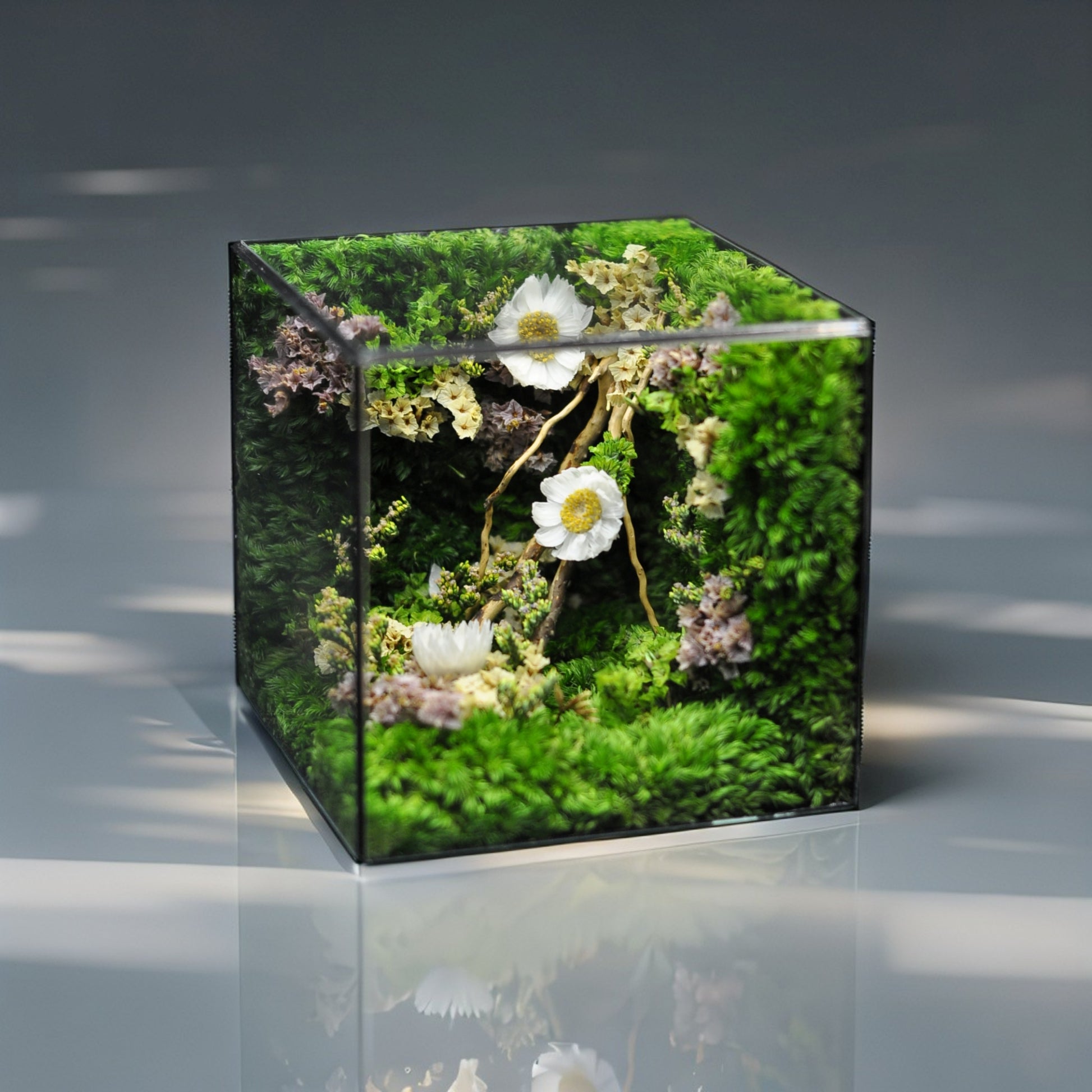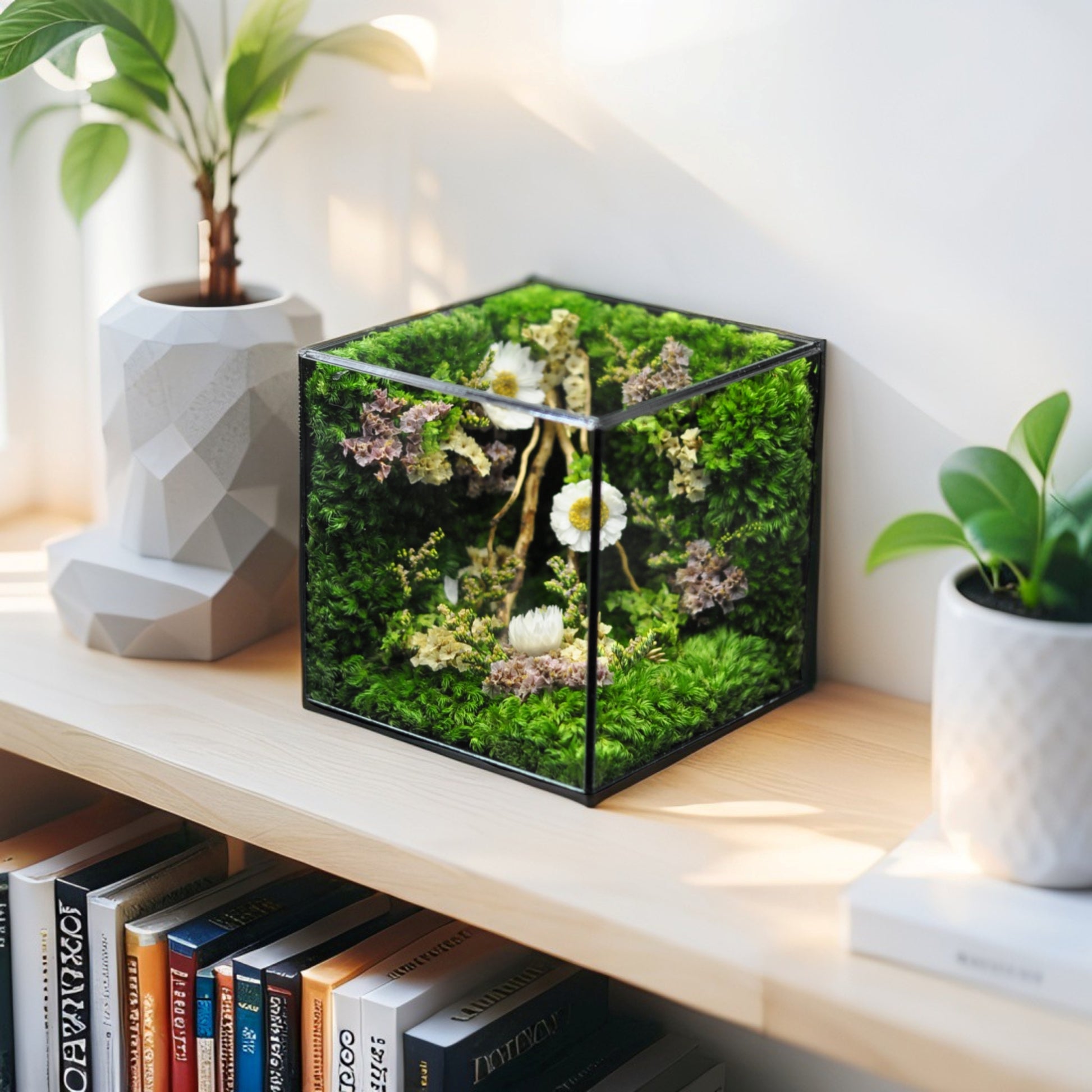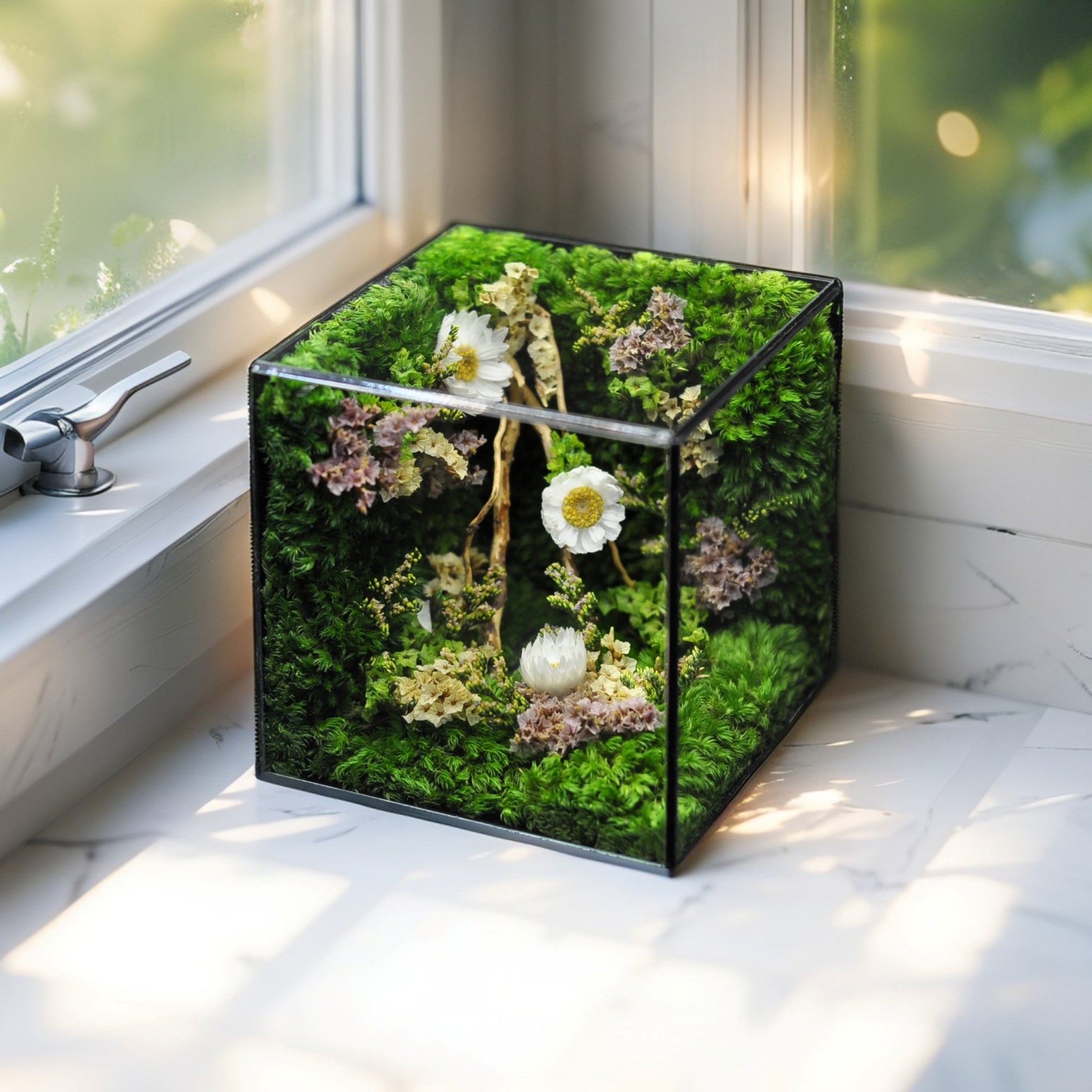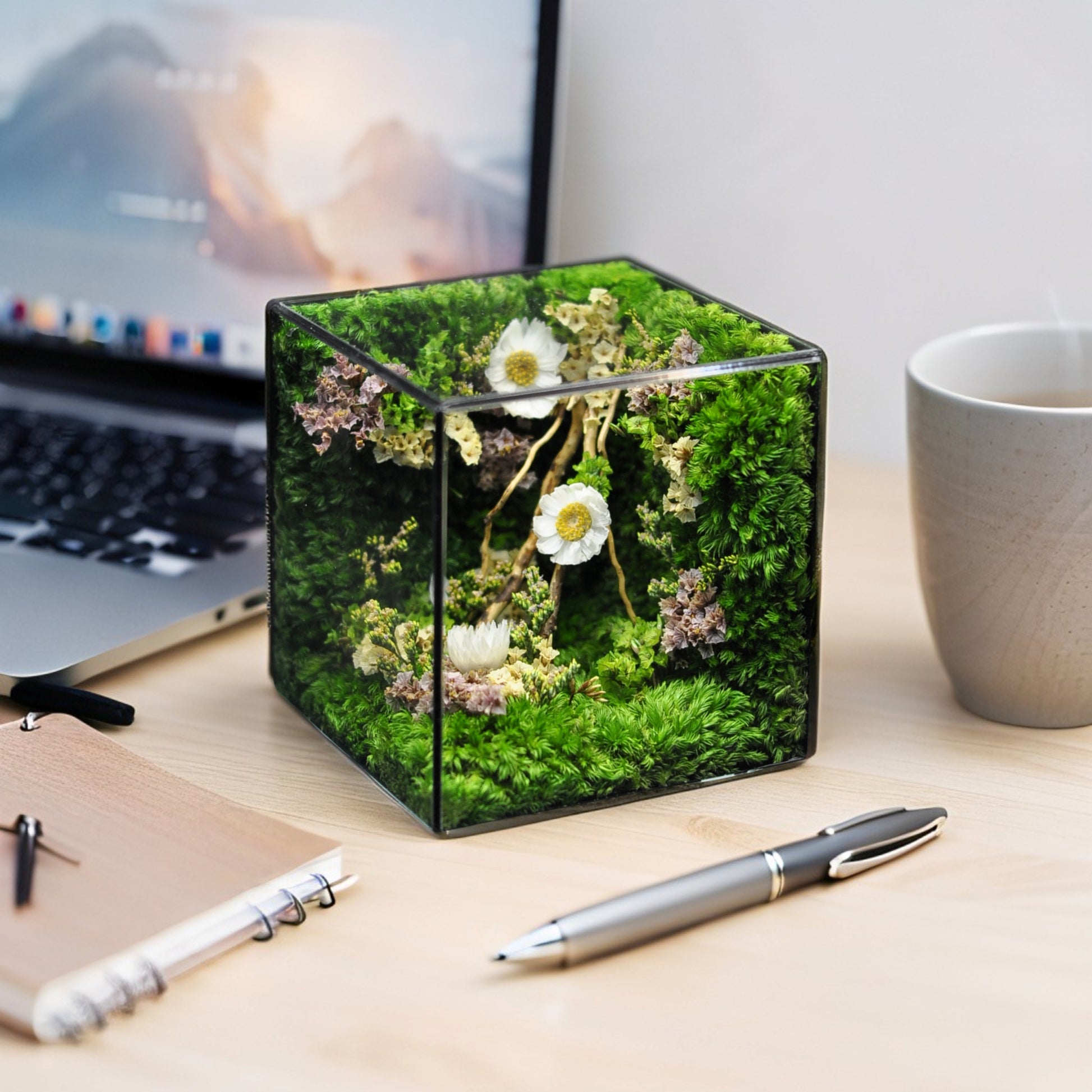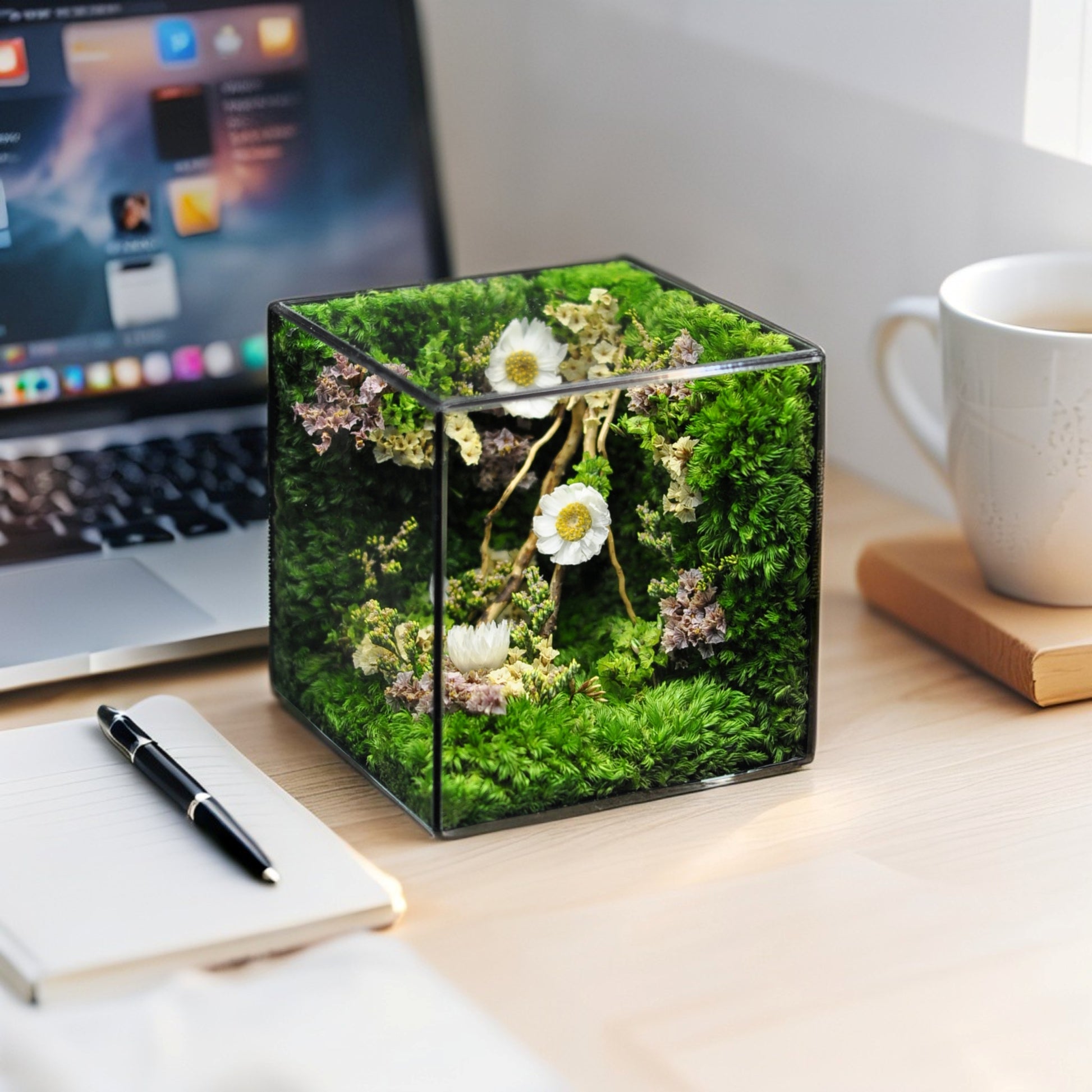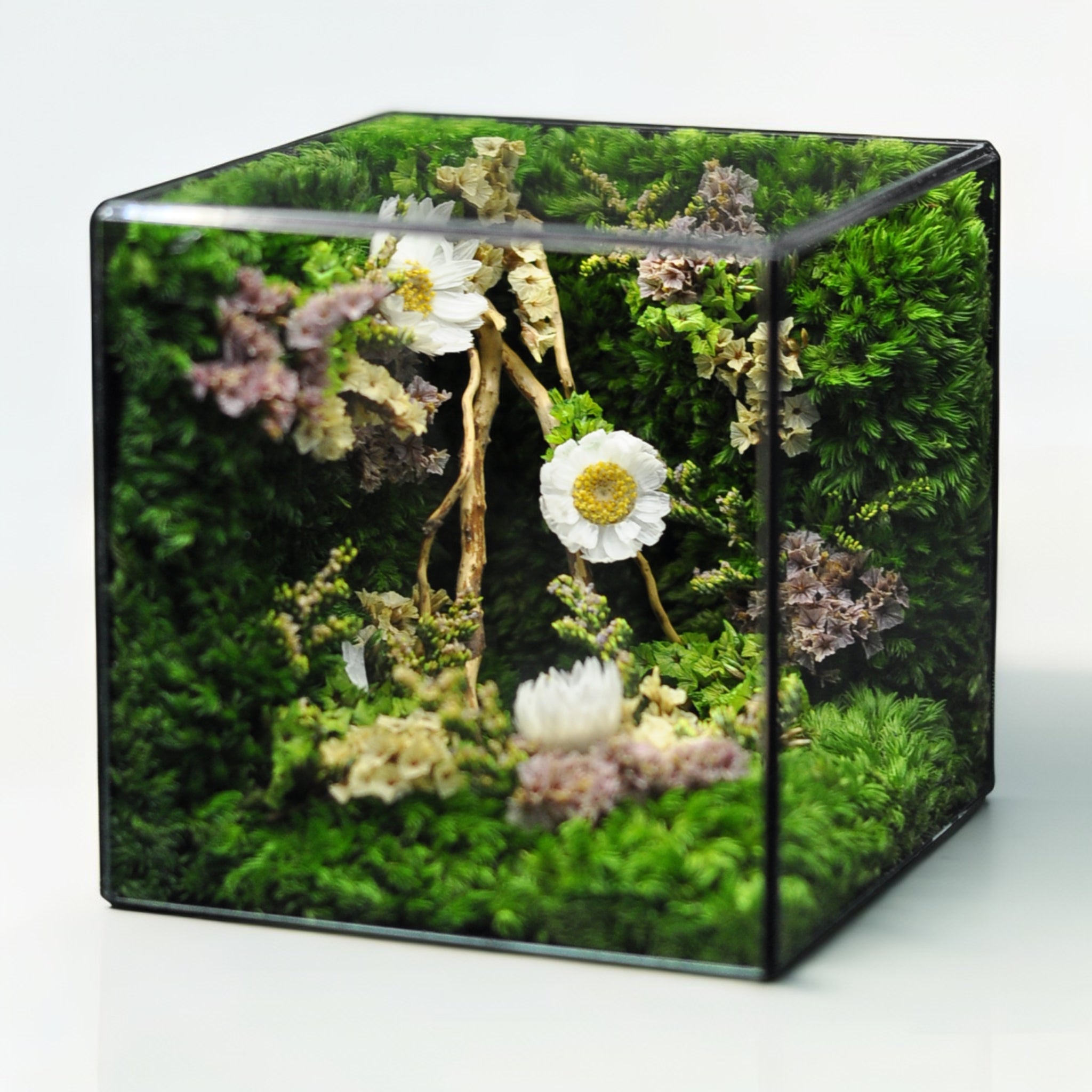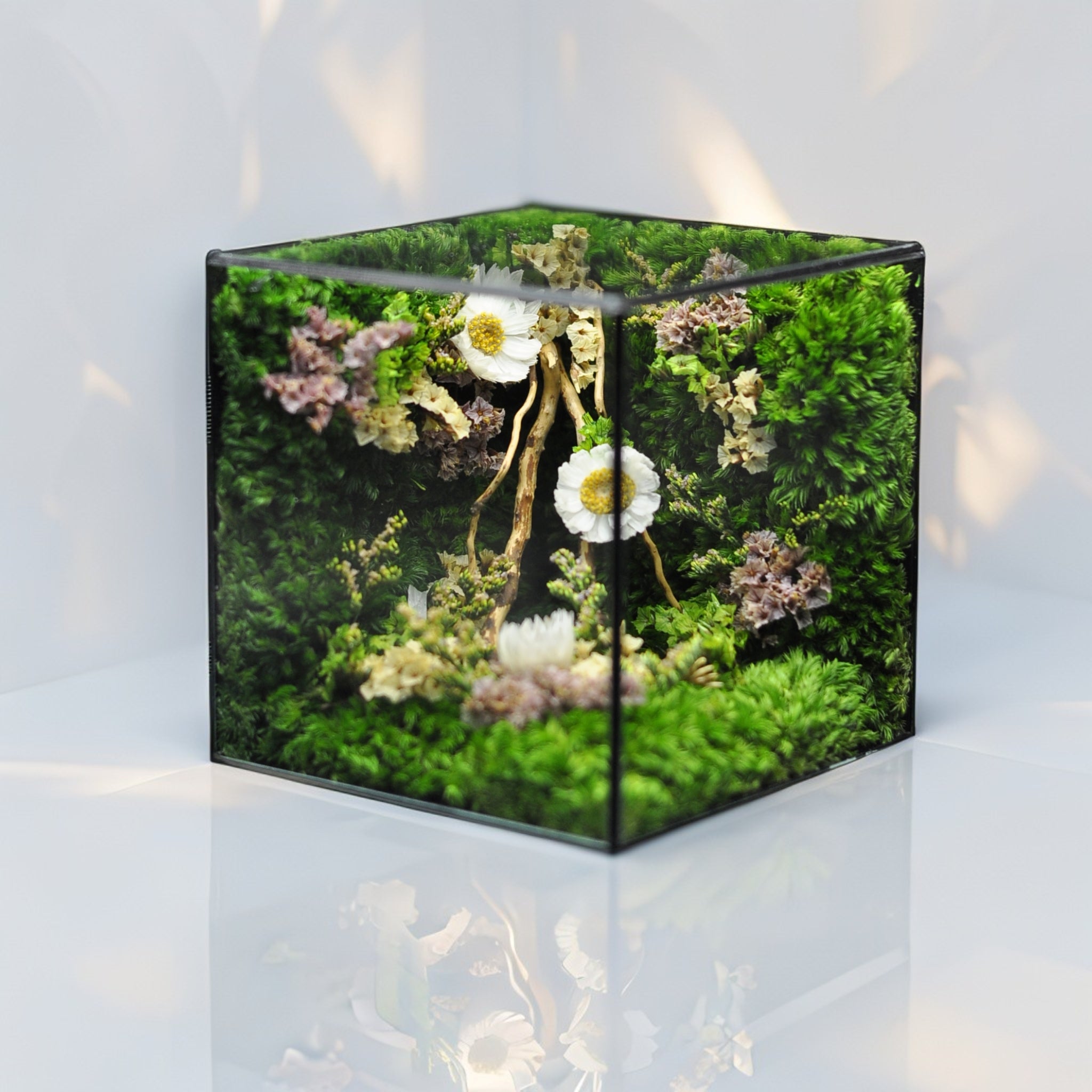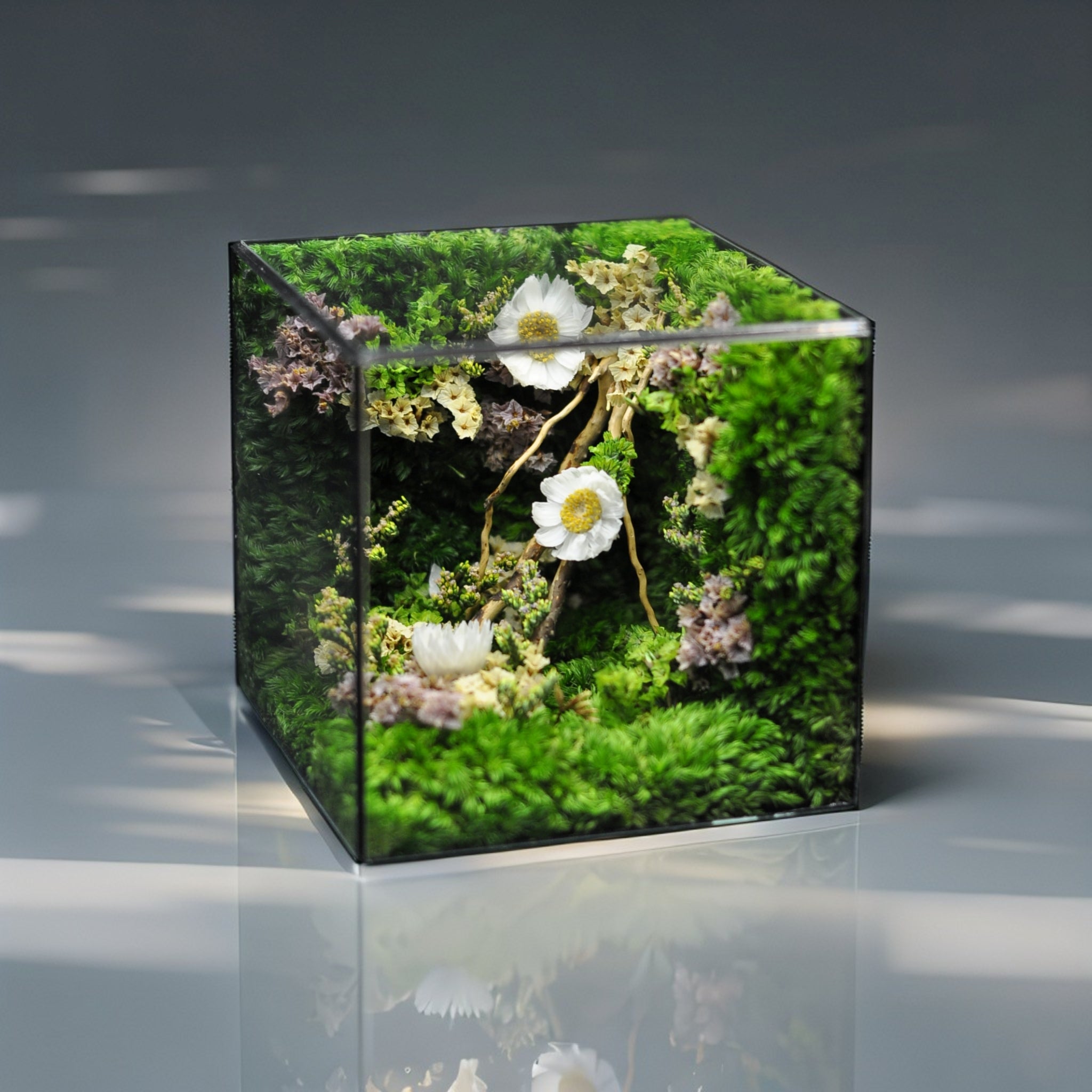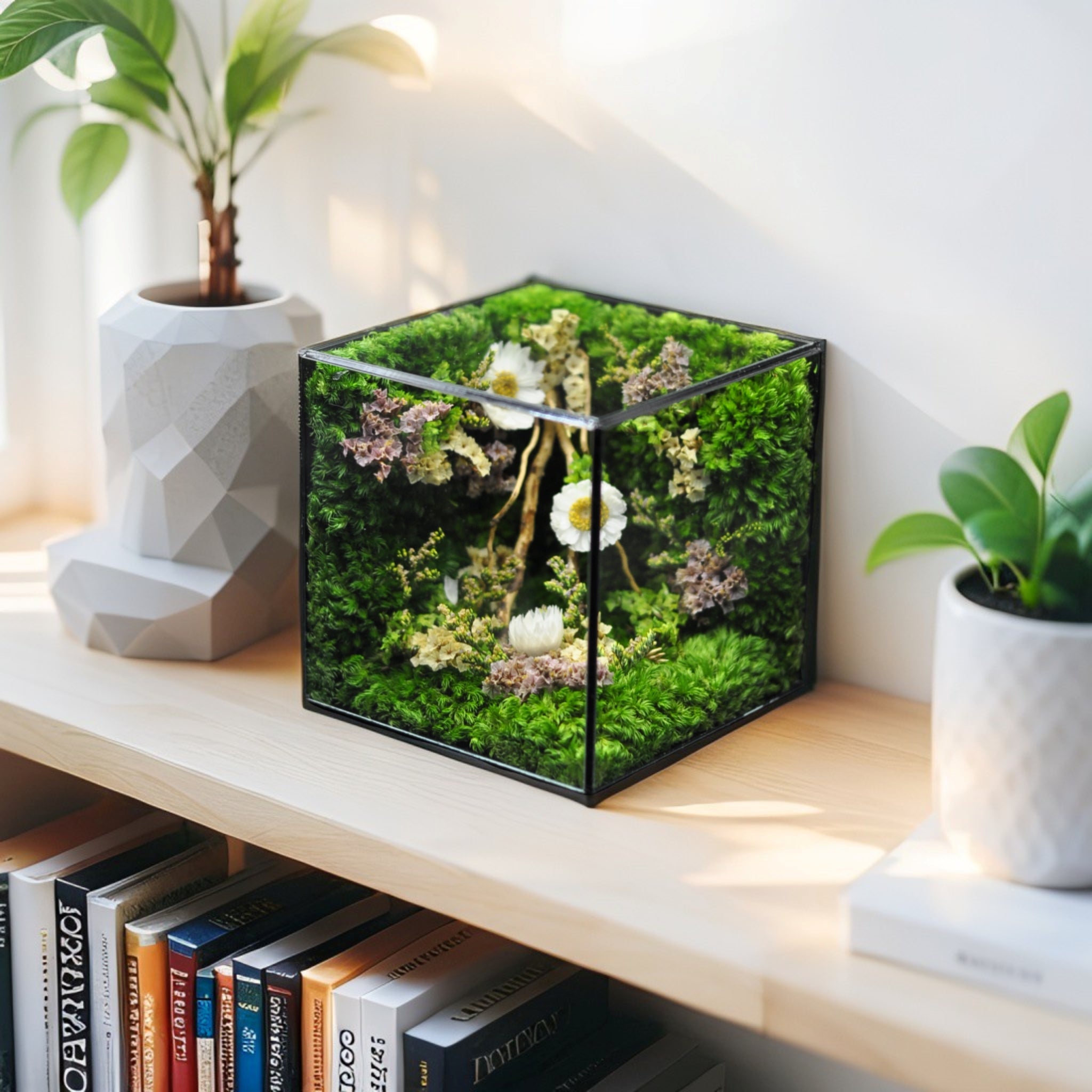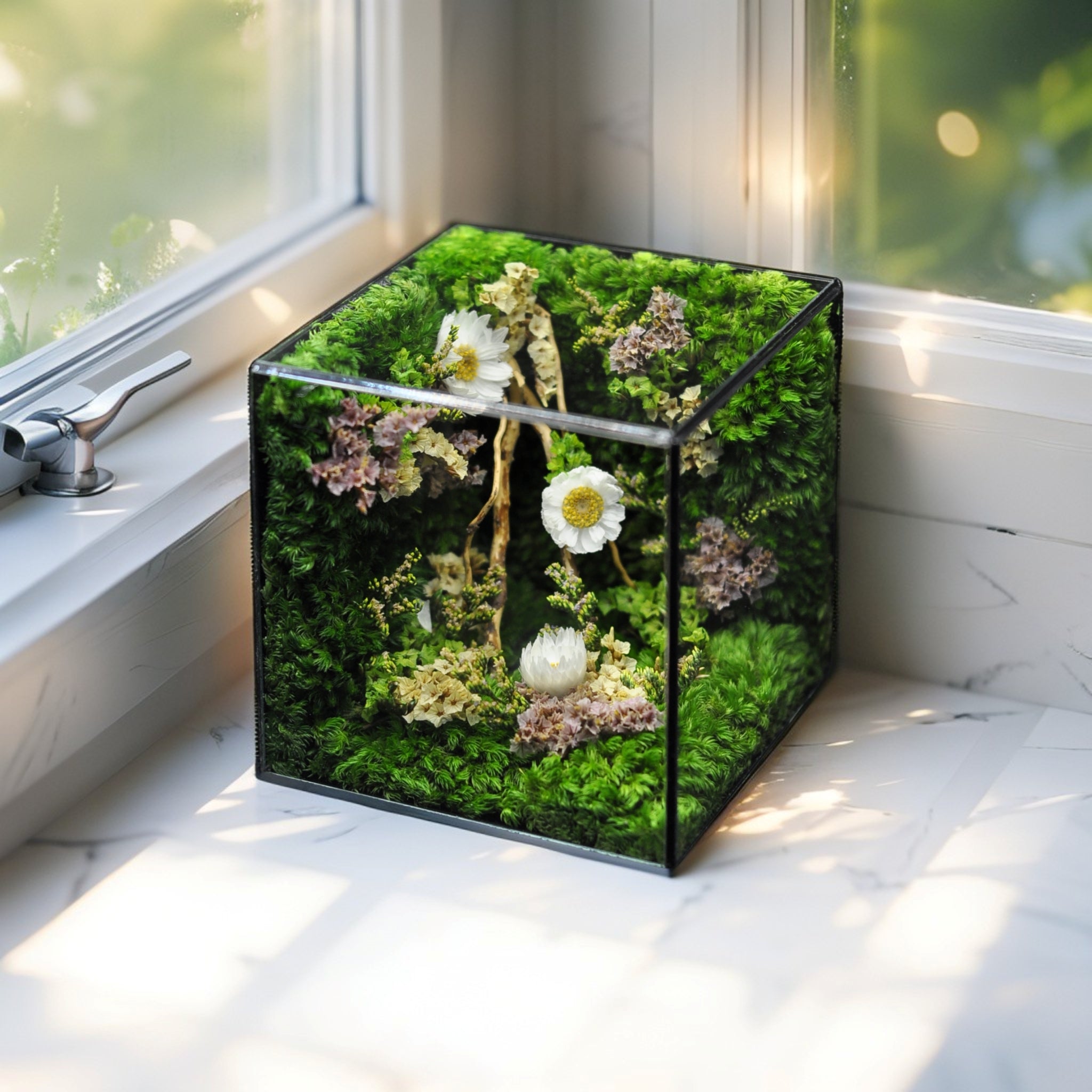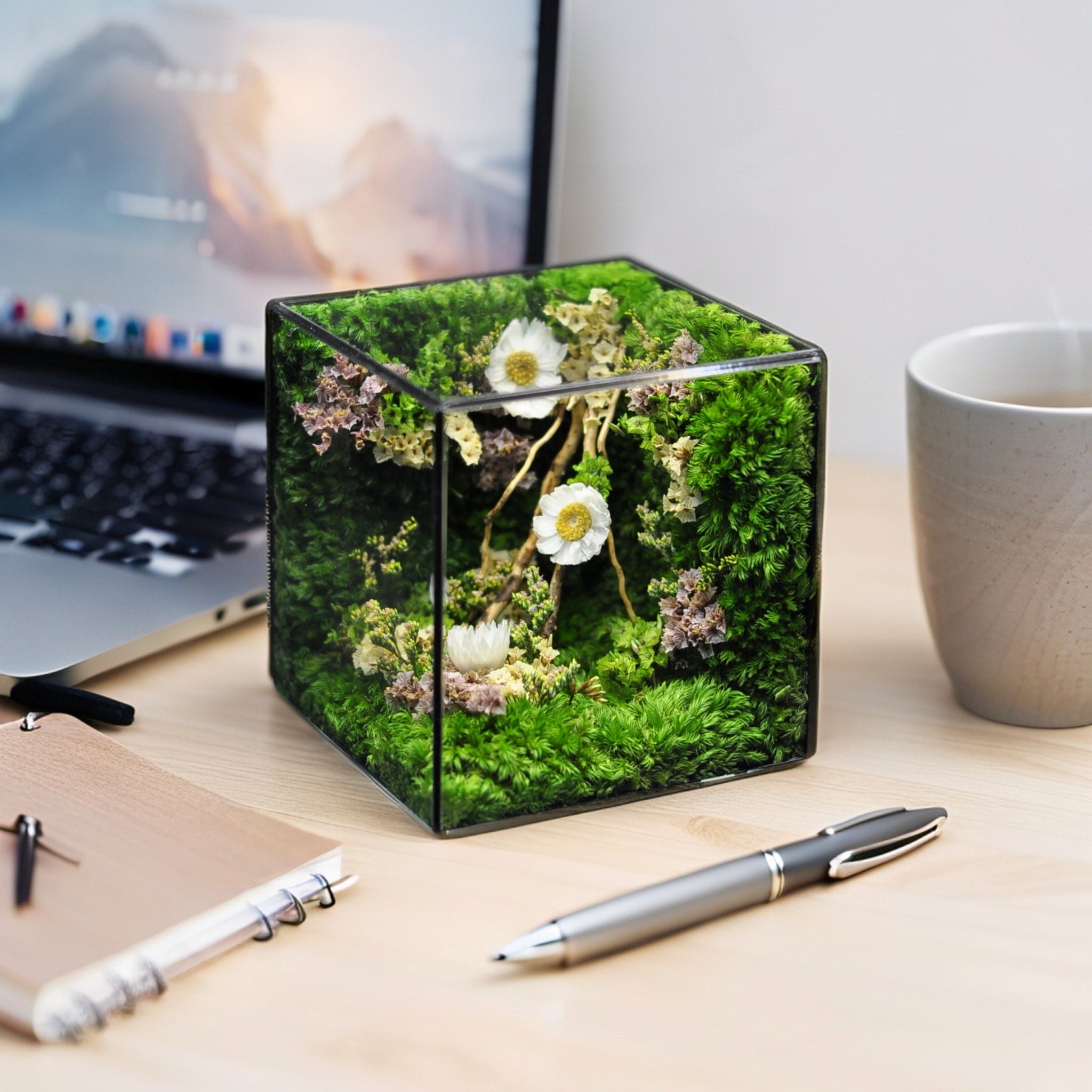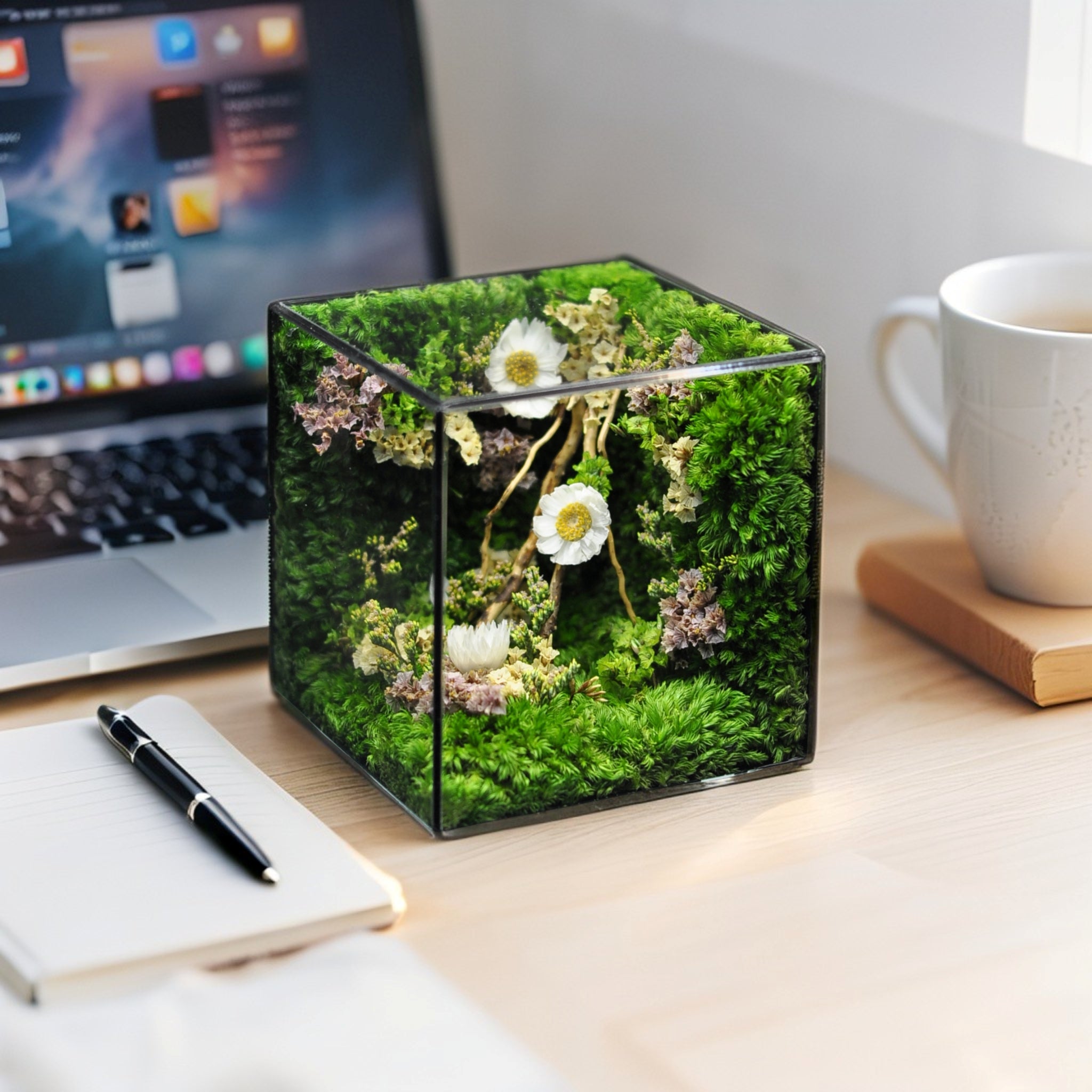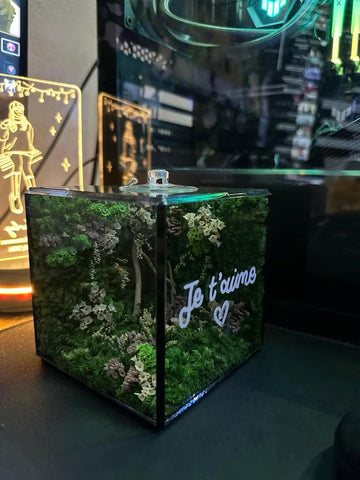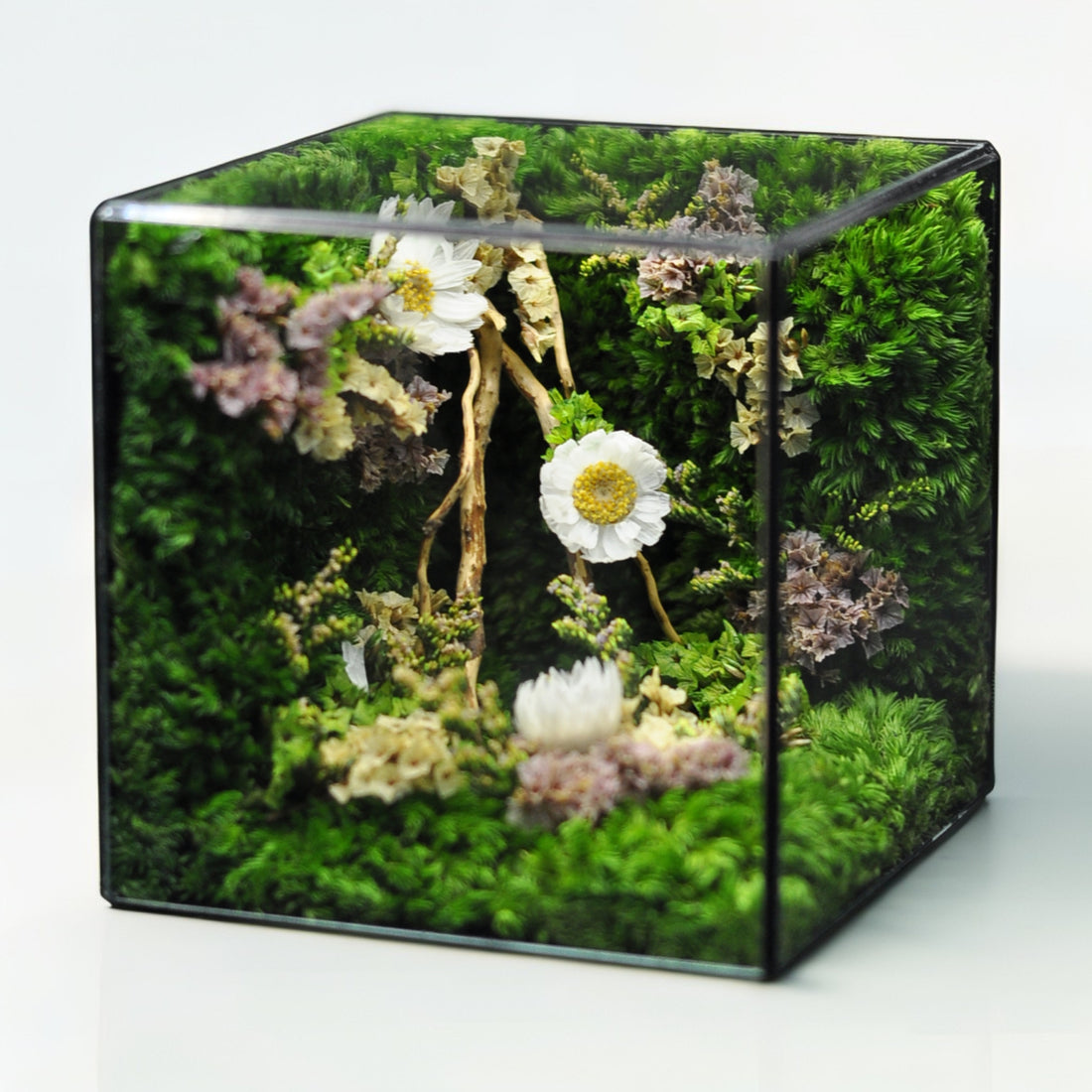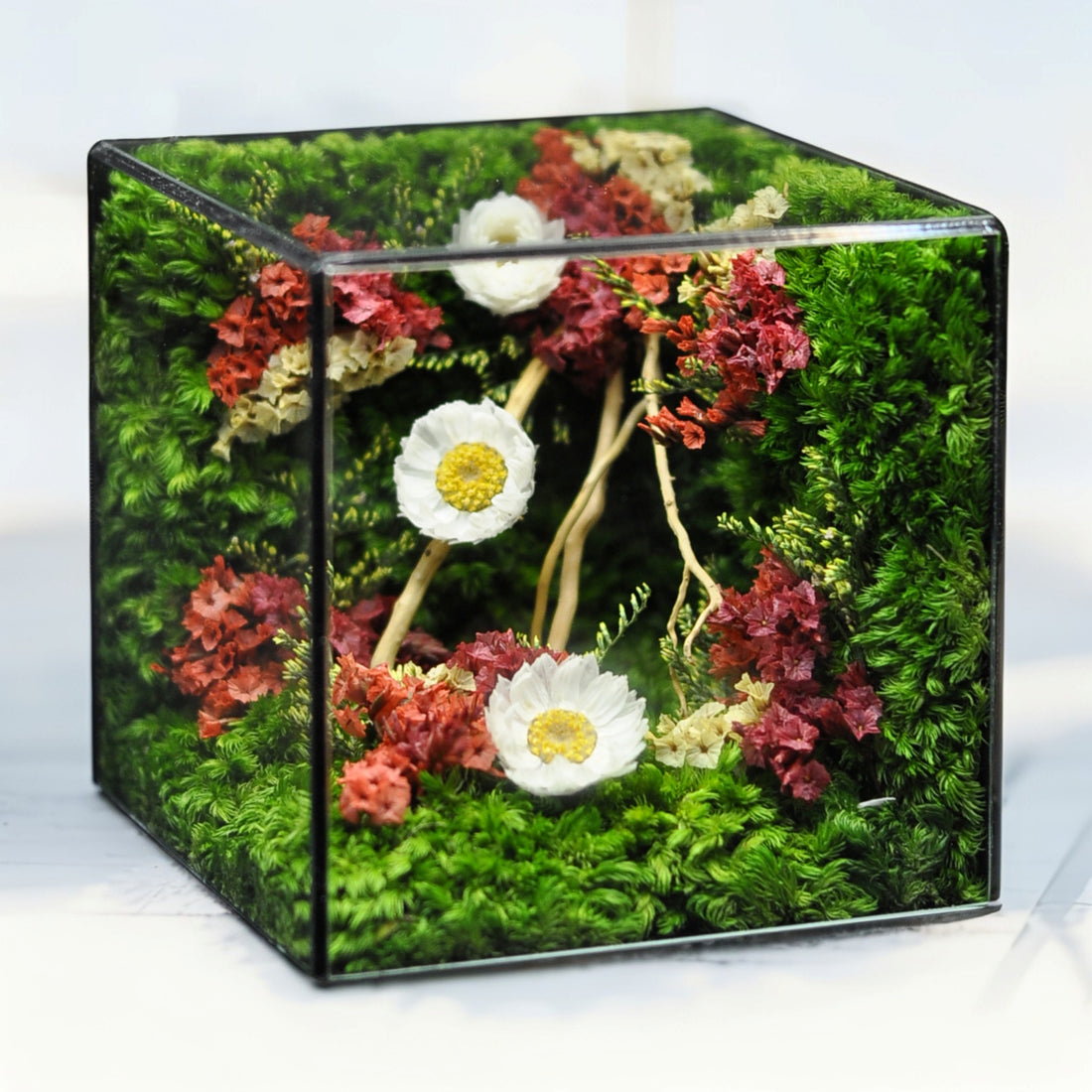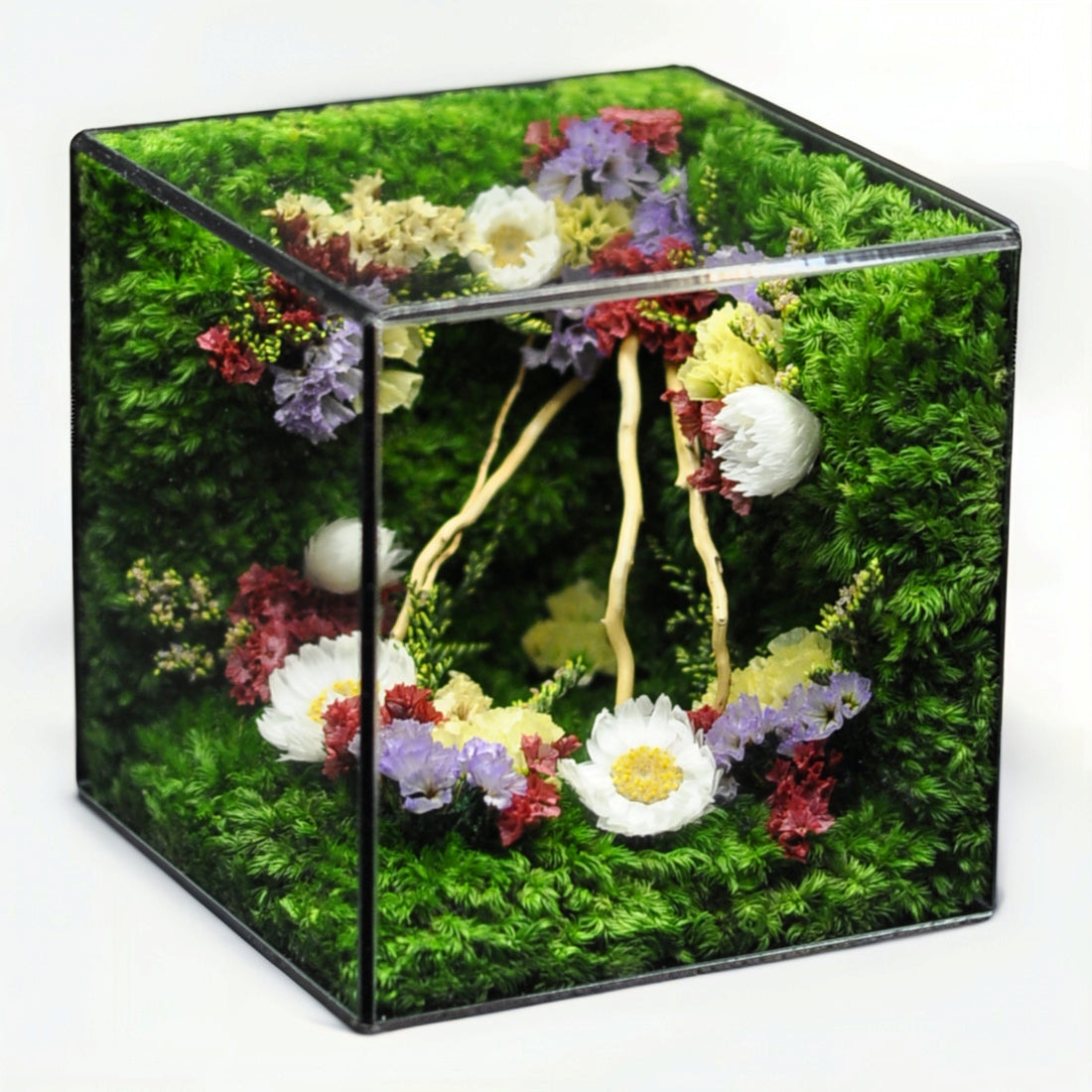Key Takeaways
Preserved moss terrariums bring vibrant, evergreen greenery into any space without the fuss of live plants. Below are the essential takeaways to help you choose, assemble, and maintain your perfect preserved moss display—complete with expert tips on kits, styles, care, and color longevity.
- Match moss types to your design vision: Choose sheet moss for uniform coverage or reindeer moss for sculptural texture, ensuring your terrarium complements its environment.
- Opt for all-in-one DIY kits to simplify assembly: Look for kits that include moss, substrate, tools, and step-by-step instructions to get your terrarium up and running in minutes.
- Weigh low-maintenance benefits against static greenery: Preserved moss never needs watering or pruning, but it won’t grow or change shape—perfect for consistent décor without surprises.
- Guard your green hues with UV-smart placement: Avoid direct sunlight or use UV-resistant glass to prevent color fading, ensuring your moss stays vibrant for years.
- Select premium preserved moss for lasting quality: Seek suppliers who use food-grade glycerin and natural pigments, delivering softer texture and truer color that won’t crumble or discolor.
- Budget wisely by comparing kit styles and costs: Entry-level terrarium kits start around $30, while custom or wall-art options can run $100+, so balance price against size, container quality, and included accessories.
- Elevate interiors with preserved moss wall art options: Frame or panel preserved moss to create living wall pieces that double as sound-absorbing décor and focal-point accents.
- Maintain pristine displays with minimal upkeep: Simply dust occasionally, avoid moisture, and keep your terrarium in stable indoor conditions for decades of green tranquility.
With these insights in hand, you’re ready to dive into our complete guide on preserved moss terrariums—from choosing the best kit and moss type to placement strategies and care routines that guarantee lasting vibrancy.
Introduction
Ever wondered how to bring a touch of nature indoors without the commitment of live plants? Preserved moss terrariums offer a vibrant solution, bringing lush greenery into your home or office while eliminating the hassles of watering and pruning. These unique creations transform any space with their evergreen charm, making them a perfect décor choice for those seeking beauty with minimal effort.
In this comprehensive guide, we'll explore the world of preserved moss terrariums, covering everything from selecting the ideal kit and moss type to expert care tips that ensure lasting vibrancy. With informed choices and creative designs at your fingertips, you’ll learn how to elevate your interiors effortlessly—creating a stunning showcase that thrives on simplicity and style.
Benefits and Drawaws of Preserved Moss Terrariums
Considering a fuss-free green décor solution that stays vibrant season after season? Preserved moss terrariums deliver year-round lushness without the chores of live plants. Here’s why they’re winning hearts—and what to watch for before you buy.
Key Advantages of Preserved Moss
- Evergreen appeal: retains lush color and form year-round with zero watering or pruning
- Instant greenery: unboxed and ready display—no setup delays
- Consistent décor without seasonal changes: perfect for holiday transitions
- Allergy-friendly: no spores, pollen, or mold risk
- Acoustic & aesthetic appeal: ½"–1" thick moss can absorb up to 20% of mid-range frequencies*
- Versatility: ideal for terrariums, wall art, centerpieces—no soil or drainage needed
*Compared with live moss—which needs soil, moisture, and indirect light but can self-repair—preserved moss wins on maintenance, while live moss offers evolving growth.
Limitations and Considerations
- Static growth: no sprouting or self-repair; faded or damaged areas require replacement
- UV sensitivity: prolonged UV exposure (UV index > 5) leads to fading—use UV-resistant glass or indirect light placement
- Initial investment vs. long-term value: typical kits range from $30 to $200+ (2023 prices)
- Dust accumulation: regular gentle cleaning every 2–4 weeks is essential
- No air filtration: does not photosynthesize or remove VOCs
Mold & Pest Prevention
Preserved moss is sterilized, but high humidity (> 60% RH) can invite mold or dust mites. Maintain 30–50% RH and include desiccant packs in sealed displays.
Pro Tip: Unpack new moss immediately to prevent condensation damage.
Different Types of Preserved Moss and How to Choose Them
Now that you know the perks and pitfalls, let’s match moss varieties to your design vision.
Sheet Moss: Uniform Coverage for Modern Designs
Sheet moss (Pleurocarpous, mat-forming species) comes as flat, carpet-like mats.
- Best for minimalist or Scandinavian interiors craving a sleek green backdrop
- Installation: adheres easily to flat surfaces—ideal for base layers in terrariums and wall panels
- Texture & look: consistent color and low relief for crisp lines and geometric layouts
Reindeer Moss: Sculptural Texture and Depth
Reindeer moss (Cladonia rangiferina lichen) forms cloud-like clusters.
- Best for 3D accents and focal points in terrariums
- Handling: use stainless steel tweezers, silicone-tipped tongs, or DIY skewers-turned-tweezers to avoid crushing branches
- Aesthetic impact: dramatic contrast against smoother moss types
Other Varieties: Cushion Moss, Haircap Moss, etc.
- Cushion Moss (Leucobryum glaucum): dense, dome-shaped tufts for soft mounds
- Haircap Moss (Polytrichum commune): upright stems mimic mini forest scenes—great for vertical height
- Mood Moss blends: curated mixes with varied hues for dynamic displays
Matching Moss Types to Your Design Vision
- Modern & Minimal: sheet moss + single haircap moss accent
- Organic & Layered: mix sheet, cushion, and reindeer clusters
- Textured Focal Point: large reindeer formations on a dark substrate
- Monochromatic Wall Art: uniform sheet or cushion moss in matching frames
DIY Preserved Moss Terrarium Kits & Assembly
Ready to transform your space? Let’s explore kit options and build your own preserved moss terrarium.
What’s Inside a Typical Terrarium Kit
- Container: glass or UV-resistant acrylic vessel
- Moss assortment: sheet, reindeer, and cushion moss
- Substrate: decorative gravel, sand, or bark chips
- Adhesives: non-toxic craft glue, hot-melt sticks, or silicone
- Tools: stainless steel tweezers or silicone tongs
- Decorative accents: pebbles, driftwood, miniature figures
- Instructions: step-by-step templates and design ideas
[Explore our DIY preserved moss terrarium kits] for deeper tool recommendations.
Top Picks: Best Preserved Moss Terrarium Kits
Imagine gifting the Moss & More Deluxe Kit—unpacking a UV-coated glass bowl ready to amaze on day one. Here are our 2023 favorites:
- Moss & More Deluxe Kit
- Container: UV-resistant glass bowl
- Moss mix: sheet + reindeer
- Extras: glass dome cover, decorative pebbles
- Price range: $60–$70
- Terrarium Tribe Starter Bundle
- Container shapes: globe, cube, bell jar
- Moss: cushion + haircap
- Tools: mini glue gun + extra sticks
- Price range: $50–$75
- GreenCrafts Premium Experience
- Custom-cut sheet moss panels
- LED spotlight (2700K, UV-filtered)
- Stainless steel tweezers + acrylic risers
- Price range: $100–$150
How to Build a Preserved Moss Terrarium: Step-by-Step
Phase 1: Prep
- Lay kraft paper or silicone mat; wear gloves.
- Clean container with isopropyl alcohol; dry thoroughly.
Phase 2: Assembly
- Create base: add gravel or bark; smooth evenly.
- Test adhesive on a moss scrap—ensure no color bleed.
- Apply glue in small dots; press sheet moss onto substrate.
- Place accent moss (reindeer, cushion) using tweezers.
Phase 3: Finishing
- Arrange pebbles and décor elements; wipe edges for clean lines.
- Let adhesive cure 30–60 minutes before display.
Average Cost of Preserved Moss Terrarium
- Entry-Level Kits: $30–$60
- Mid-Range Bundles: $60–$100
- Premium Sets: $100–$200+
Costs vary by brand, container quality, and accessories.
Avoiding Common Pitfalls During Assembly
- Overloading moss: aim for 60–70% initial coverage to avoid clutter
- Skipping glue tests: prevent adhesive bleed and color spots
- Ignoring clean edges: wipe rims before glue dries for crisp lines
- Forgetting UV protection: use UV-resistant glass or indirect light placement
Preserved Moss Wall Art & Alternative Displays
Preserved moss extends beyond terrariums—create stunning wall art and living panels.
Framed Panels and Living Wall Pieces
- DIY panel kits: attach moss to cork or foam board, insert into shadowbox frames
- Modular tiles: interlocking frames for large-scale green walls
- Acoustic moss boards: specialized panels that decorate and dampen noise
Installation Tips for Vertical Displays
- Use anchor-rated screws or toggle bolts for heavy panels
- Maintain a 2–3" air gap behind panels for ventilation
- Cover framed art with UV-resistant plexiglass to prevent fading
- Level with a laser or bubble level—moss art reveals crooked lines instantly
Placement Strategies & Color Longevity
Strategic placement ensures your moss stays vibrant for years.
UV-Smart Placement to Guard Green Hues
- Indirect light only: position 3–5 feet from south/west windows
- UV-resistant glass: filters out UV below 400 nm for up to twice the color life
- Artificial lighting: use LED strips (2700K–3000K) with UV filters—no bleaching
Indoor Climate: Humidity, Temperature, and Airflow
- Ideal Humidity: 30–50% RH—too high invites mold; too low has no effect on preserved moss
- Temperature Range: 60–80°F preserves adhesive and pigment stability
- Airflow: gentle circulation prevents dust build-up; avoid direct HVAC blasts
Care and Maintenance for Lasting Vibrancy
A simple care routine keeps your display fresh.
Simple Dusting and Cleaning Routines
- Brush with microfiber or soft artist’s brush every 2–4 weeks
- Use compressed air in short bursts (6–8" away) to avoid dislodging moss
- Clean container exterior only; never introduce liquids to moss
Moisture Control: Keeping Terrariums Dry
- No watering: preserved moss degrades if wet
- Include silica gel packs in sealed displays
- Place away from bathrooms and kitchen steam
Recognizing and Addressing Color Fading
- Inspect quarterly for dull spots
- Use a re-glycerin spray (test on scrap first) to restore suppleness
- Relocate fading areas to lower-light zones or behind UV-filtered glass
Long-Term Tips: Decades of Evergreen Tranquility
- Rotate wall panels 180° annually to equalize light exposure
- Schedule a “moss spa day” every 2–3 years: dust, inspect, and reattach loose patches
- Keep a simple log of placement and care dates to catch gradual changes
Buying Guide: Selecting Quality Moss & Suppliers
Choosing reputable suppliers protects your investment.
Quality Indicators: Food-Grade Glycerin & Natural Pigments
- Food-Grade Glycerin: prevents brittleness and preserves texture
- Natural Pigments: avoids artificial dyes that may leach or fade
- pH-Neutral Preparation (pH 6.5–7.5): ensures adhesive compatibility and color stability
Evaluating Supplier Reputation & Certifications
- Moss & More: ISO 9001-certified, food-grade glycerin, 30-day returns
- Terrarium Tribe: FSC-certified backings, sustainable harvest, 60-day satisfaction guarantee
- ForestScapes: PEFC certification, documented traceability, bulk discounts, free shipping over $75
Shipping Considerations
- Look for moisture- and impact-controlled packaging
- Unpack immediately on arrival to prevent condensation damage
- Check for mold or color bleed before installation
Warranty, Return Policies, and Sustainable Sourcing
- Satisfaction guarantees: 30–60-day returns on defective or damaged moss
- Traceability: suppliers who share harvest origin demonstrate environmental responsibility
- Fair trade: ethical compensation practices support local harvesters
Budget Considerations & Value Comparison
Imagine snagging a premium preserved moss kit at 25% off during a spring sale—now that’s value. Here’s how different tiers stack up:
Entry-Level vs. Custom Kits: What to Expect
- Entry-Level: $30–$60 for basic bowls and moss—perfect for beginners
- Custom: $100–$300+ for bespoke frames, premium blends, and branded displays
Cost vs. Container Quality & Included Accessories
- Glass vs. Acrylic: glass is clearer and scratch-resistant; acrylic is lighter but may yellow
- Bundled tools: kits that include tweezers, adhesives, and décor save 15–20% compared to sourcing separately
- Packaging & shipping: fragile items may incur higher fees—factor this into total cost
Tips to Maximize Value Without Sacrificing Quality
- Buy moss in bulk: many suppliers offer 10–20% discounts on larger packs
- Repurpose containers: upcycle jars, bottles, or thrifted vessels
- Shop seasonal promotions: holiday and spring sales often include terrarium kit discounts
Case Studies & Testimonials
Real-world examples illustrate the impact of preserved moss décor.
Office Lobby Installation: A Real-World Example
At GreenWave Tech HQ, a 12×8-ft moss wall went up in 2020:
- Materials & labor: $2,500
- Anecdotal outcome: measured up to 30% noise reduction with mid-range frequency meters
- Longevity: minimal fading after 3 years behind UV-filtered glass
- Employee feedback: 87% report improved well-being in the space
Home Hobbyist Success Story
“I built my first preserved moss terrarium using the Terrarium Tribe Starter Bundle. It took under an hour, and friends can’t stop asking where I got it!”
—Marisol D., LA
Data & Evidence: Longevity Stats & Satisfaction Rates
According to the 2022 Green Interiors Survey by GreenSpace Publishing, 85% of preserved moss terrarium owners remained satisfied after 3 years, with color retention typically lasting 5–7 years in optimal conditions.
Frequently Asked Questions
Do You Need Live or Preserved Moss for a Terrarium?
Live moss requires soil, moisture, and indirect light but can self-renew. Preserved moss demands zero watering or soil—ideal for low-light, low-care décor.
What Types of Preserved Moss Are Best for Terrariums?
- Sheet Moss: even coverage and sleek backdrop
- Reindeer Moss: dramatic, puffy accents
- Cushion & Haircap Moss: layering and vertical interest
Mix varieties to suit your container shape and style vision.
How Do I Care for a Preserved Moss Terrarium?
- Dust every 2–4 weeks with a soft brush or compressed air
- Keep completely dry; no sprays or watering
- Avoid direct sunlight; use UV-smart placement or UV-resistant glass
Expert Tips & Final Checklist
Quick-Reference Checklist: Kit Selection → Placement → Care
Kit Selection
- Verify food-grade glycerin and natural pigments
- Ensure UV-resistant container or plan for indirect lighting
- Check included tools: tweezers, adhesive, décor accents
Placement
- Indirect light only, 3–5 ft from bright windows
- Stable environment: 60–80°F, 30–50% RH
- Secure wall art with appropriate anchors and air gap
Care
- Dust with microfiber or soft brush every 2–4 weeks
- Maintain dryness; add desiccant packs if sealed
- Inspect annually for fading; apply re-glycerin treatment if available
Pro Hacks for Customizing Designs and Ensuring Durability
- LED accent lighting: warm-white LEDs (2700K–3000K) behind moss panels highlight texture without UV
- Seasonal swaps: rotate red-tinted reindeer moss or add holiday-themed accents
- Mixed-media displays: combine preserved moss with driftwood, metal, or live succulents
- Documentation: photograph and date installations to track fading and plan refresh cycles
With these expert insights and checklist in hand, you’re ready to select, assemble, place, and maintain a preserved moss terrarium or wall art piece that dazzles for years to come.
Conclusion
Preserved moss terrariums present an attractive and low-maintenance solution for enhancing indoor spaces with sustainable greenery. As detailed throughout this article, their many advantages include year-round vibrancy, allergy-friendly properties, and unique acoustic benefits, making them a worthy addition to various design aesthetics without the commitments associated with live plants. Understanding their limitations, such as the need for careful placement and regular maintenance, ensures that the moss remains a vibrant decorative element for years.
In choosing the right preserved moss varieties and assembling a terrarium or wall display, you can create a personalized atmosphere that not only enriches your environment but also reflects your individual style. As you embark on this creative journey, remember that proper care and strategic placement are critical to preserving the beauty of these artistic compositions. With the right approach, your preserved moss décor can become a timeless highlight of your home or office, inspiring tranquility and admiration for many seasons ahead.
Frequently Asked Questions (FAQ)
Q: Do you need live or preserved moss for a terrarium?
A: Live moss requires soil, moisture, and indirect light but can self-renew. Preserved moss demands zero watering or soil—ideal for low-light, low-care décor.
Q: What types of preserved moss are best for terrariums?
A: Sheet moss provides even coverage for a sleek backdrop, reindeer moss offers dramatic, puffy accents, and cushion & haircap moss are great for layering and vertical interest. Mix varieties to suit your container shape and style vision.
Q: How do I care for a preserved moss terrarium?
A: Dust every 2–4 weeks with a soft brush or compressed air, keep it completely dry without sprays or watering, and avoid direct sunlight using UV-smart placement or UV-resistant glass.
Q: What are the benefits of using preserved moss terrariums?
A: Preserved moss terrariums provide year-round greenery without the need for watering or pruning, are allergy-friendly, and offer acoustic benefits by absorbing mid-range frequencies. They also require minimal maintenance.
Q: What should I consider before buying a preserved moss terrarium kit?
A: Consider the initial investment versus long-term value, ensure the kit includes food-grade glycerin and natural pigments, and check if the container is UV-resistant to prevent fading.
Q: How do I assemble a preserved moss terrarium?
A: First, prepare your container and surface, add a base layer of gravel or bark, apply adhesive to the substrate, place sheet moss and accents using tweezers, and finish by arranging decorative elements before allowing glue to cure.
Q: How can I prevent color fading in preserved moss?
A: To prevent fading, ensure indirect light placement, use UV-resistant glass, and inspect periodically for dull spots, applying a re-glycerin spray if necessary.
Q: How often should I clean a preserved moss terrarium?
A: Regular gentle cleaning is essential every 2–4 weeks, using a soft brush or compressed air to keep the moss looking fresh without introducing liquids.

